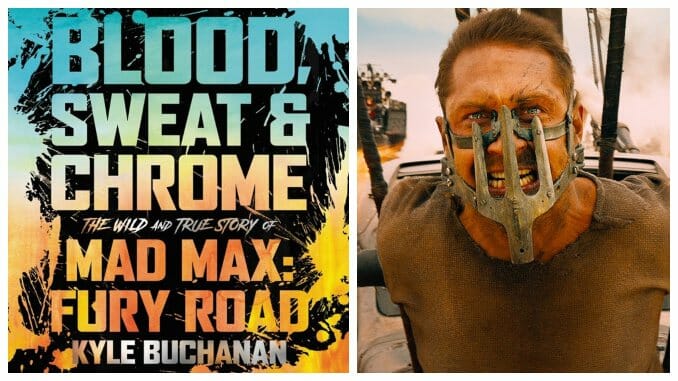Mad Max: Fury Road Oral History Blood, Sweat & Chrome Stays Neck-And-Neck with Its Subject

“Why do these people invest so much of their love in turning it almost fetishistically into a thing of art? Well, it’s the only thing they done got.”
Production designer Colin Gibson might’ve been talking about the desperate and cancer-ridden War Boys populating director George Miller’s post-apocalyptic Mad Max: Fury Road, but he could’ve just as easily been describing those he worked with on the film itself. Where Immortan Joe’s testosterone-fueled kamikaze zealots enhanced their vehicles—which act as both their sole symbols of self-actualization and their final resting places—with skull steering wheels, revolver-and-femur gear shifts and electric guitar amps, Miller and his team of obsessives were cannibalizing hot rods and engineering steel acrobatic poles in order to realize their own fetishistic art. Only one of these groups had shaved heads and spray-painted faces, but if you’d told me they’d shared that too, I wouldn’t have thought twice.
Over the course of Fury Road’s lengthy and troubled production, a heat-seeking dedication to perfection (in translating Miller’s vision to the screen, if not a platonic car-chase ideal) was something to which everyone could cling. In Kyle Buchanan’s Blood, Sweat & Chrome: The Wild and True Story of Mad Max: Fury Road, the New York Times journalist expands his oral history of the acclaimed 2015 action movie to a similarly detailed extreme that the ambitious, cut-no-corners Miller would find kinship with.
Nearly 400 pages of interviews document the highway to hell taken by everyone working on the film, ranging from stars Tom Hardy and Charlize Theron to VFX data wranglers affectionately nicknamed “Toast.” Buchanan tracked everyone down and got everyone to talk—something difficult to do in modern Hollywood, where interviews are notoriously hedged and industry players remain tight-lipped lest their verbal indiscretions go viral. But when a high stakes, low odds bet like Fury Road pays off at the box office ($375M), Oscars (10 nomination, six wins) and history books (topping dozens of “best of the decade” lists), some of the pressure is off of the underdogs. The results are gripping, candid and charmingly still flabbergasted that they were able to pull the whole thing off. Let alone pull it off without many, many casualties.
“I can say that pretty much every day, someone was in danger,” testifies stunt performer Scotty Gregory. Part of getting swept up in Blood, Sweat & Chrome’s magic is that, not only do you believe him, you also have full faith that Miller truly prioritized safety during the manic shoot (the production had no major injuries). The pacing of the book—structured like the production of a film, moving from Miller’s pre-Mad Max career through Fury Road’s decades-spanning pre-production, heartbreaking variety of cancellations and delays, production, and marketing—indoctrinates you. Miller and the movie become long-suffering messiahs of what Hollywood can accomplish, even under the thumb of an IP-obsessed industry that, in 2022, seems far more likely to reboot the franchise with a TikTok star.
-

-

-

-

-

-

-

-

-

-

-

-

-

-

-

-

-

-

-

-

-

-

-

-

-

-

-

-

-

-

-

-

-

-

-

-

-

-

-

-








































